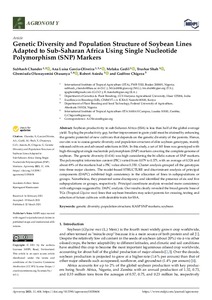| dc.contributor.author | Chander, S. |
| dc.contributor.author | Garcia-Oliveira, A.L. |
| dc.contributor.author | Gedil, M. |
| dc.contributor.author | Shah, T. |
| dc.contributor.author | Otusanya, G.O. |
| dc.contributor.author | Asiedu, R. |
| dc.contributor.author | Chigeza, G. |
| dc.date.accessioned | 2021-07-07T09:57:25Z |
| dc.date.available | 2021-07-07T09:57:25Z |
| dc.date.issued | 2021 |
| dc.identifier.citation | Chander, S., Garcia-Oliveira, A. L., Gedil, M., Shah, T., Otusanya, G. O., Asiedu, R., & Chigeza, G. (2021). Genetic diversity and population structure of soybean lines adapted to sub-Saharan Africa using Single Nucleotide Polymorphism (SNP) markers. Agronomy, 11(3), 604: 1-11. |
| dc.identifier.issn | 2073-4395 |
| dc.identifier.uri | https://hdl.handle.net/20.500.12478/7158 |
| dc.description.abstract | Soybean productivity in sub-Saharan Africa (SSA) is less than half of the global average yield. To plug the productivity gap, further improvement in grain yield must be attained by enhancing the genetic potential of new cultivars that depends on the genetic diversity of the parents. Hence, our aim was to assess genetic diversity and population structure of elite soybean genotypes, mainly released cultivars and advanced selections in SSA. In this study, a set of 165 lines was genotyped with high-throughput single nucleotide polymorphism (SNP) markers covering the complete genome of soybean. The genetic diversity (0.414) was high considering the bi-allelic nature of SNP markers. The polymorphic information content (PIC) varied from 0.079 to 0.375, with an average of 0.324 and about 49% of the markers had a PIC value above 0.350. Cluster analysis grouped all the genotypes into three major clusters. The model-based STRUCTURE and discriminant analysis of principal components (DAPC) exhibited high consistency in the allocation of lines in subpopulations or groups. Nonetheless, they presented some discrepancy and identified the presence of six and five subpopulations or groups, respectively. Principal coordinate analysis revealed more consistency with subgroups suggested by DAPC analysis. Our results clearly revealed the broad genetic base of TGx (Tropical Glycine max) lines that soybean breeders may select parents for crossing, testing and selection of future cultivars with desirable traits for SSA. |
| dc.description.sponsorship | CGIAR Research Program on Grain Legumes and Dryland Cereals |
| dc.format.extent | 1-11 |
| dc.language.iso | en |
| dc.subject | Genetic Diversity |
| dc.subject | Population Structure |
| dc.subject | Single Nucleotide Polymorphism |
| dc.subject | Genetic Markers |
| dc.subject | Soybeans |
| dc.subject | Subsaharan Africa |
| dc.title | Genetic diversity and population structure of soybean lines adapted to sub-Saharan Africa using Single Nucleotide Polymorphism (SNP) markers |
| dc.type | Journal Article |
| cg.contributor.crp | Maize |
| cg.contributor.crp | Roots, Tubers and Bananas |
| cg.contributor.crp | Policies, Institutions and Markets |
| cg.contributor.affiliation | International Institute of Tropical Agriculture |
| cg.contributor.affiliation | CCS Haryana Agricultural University |
| cg.contributor.affiliation | International Maize and Wheat Improvement Center |
| cg.contributor.affiliation | Federal University of Agriculture, Abeokuta |
| cg.coverage.region | Africa |
| cg.coverage.region | Central Africa |
| cg.coverage.region | East Africa |
| cg.coverage.region | Southern Africa |
| cg.coverage.region | West Africa |
| cg.coverage.country | Benin (Dahomey) |
| cg.coverage.country | Burundi |
| cg.coverage.country | Cameroon |
| cg.coverage.country | Cote d’Ivoire (Ivory Coast) |
| cg.coverage.country | Ethiopia |
| cg.coverage.country | Ghana |
| cg.coverage.country | Kenya |
| cg.coverage.country | Malawi |
| cg.coverage.country | Mozambique |
| cg.coverage.country | Nigeria |
| cg.coverage.country | Sierra Leone |
| cg.coverage.country | Togo |
| cg.coverage.country | Uganda |
| cg.coverage.country | Zambia |
| cg.coverage.hub | Southern Africa Hub |
| cg.coverage.hub | Headquarters and Western Africa Hub |
| cg.researchtheme | Biometrics |
| cg.researchtheme | Biotech and Plant Breeding |
| cg.researchtheme | Plant Production and Health |
| cg.identifier.bibtexciteid | CHANDER:2021 |
| cg.isijournal | ISI Journal |
| cg.authorship.types | CGIAR and developing country institute |
| cg.iitasubject | Agronomy |
| cg.iitasubject | Food Security |
| cg.iitasubject | Genetic Improvement |
| cg.iitasubject | Grain Legumes |
| cg.iitasubject | Plant Breeding |
| cg.iitasubject | Plant Genetic Resources |
| cg.iitasubject | Plant Production |
| cg.iitasubject | Soybean |
| cg.journal | Agronomy |
| cg.notes | Open Access Journal; Published online: 22 Mar 2021 |
| cg.accessibilitystatus | Open Access |
| cg.reviewstatus | Peer Review |
| cg.usagerightslicense | Creative Commons Attribution 4.0 (CC BY 0.0) |
| cg.targetaudience | Scientists |
| cg.identifier.doi | https://dx.doi.org/10.3390/agronomy11030604 |
| cg.iitaauthor.identifier | Garcia-Oliveira AL: 0000-0001-8561-4172 |
| cg.iitaauthor.identifier | Melaku Gedil: 0000-0002-6258-6014 |
| cg.iitaauthor.identifier | Trushar Shah: 0000-0002-0091-7981 |
| cg.iitaauthor.identifier | Robert Asiedu: 0000-0001-8943-2376 |
| cg.iitaauthor.identifier | Godfree Chigeza: 0000-0002-9235-0694 |
| cg.futureupdate.required | No |
| cg.identifier.issue | 3: 604 |
| cg.identifier.volume | 11 |
| cg.contributor.acknowledgements | We are grateful to Rodomiro Ortiz (Swedish University of Agricultural Sciences, Sweden) for enriching the revised manuscript. The authors appreciate and acknowledge Peter Oyelakin, Sunday Ojo, Ademola Ajayi, and Ilesanmi Yinka for their support in IITA soybean screenhouse and DNA extraction. We are also thankful to the four anonymous reviewers for discussions and their pertinent suggestions on the manuscript. |

